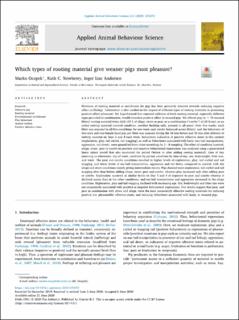| dc.description.abstract | Provision of rooting material as enrichment for pigs has been primarily oriented towards reducing negative affect (suffering). Information is also needed on the impact of different types of rooting materials in promoting positive affect (pleasure). We hypothesised that repeated addition of fresh rooting material, especially different types provided in combination, would stimulate positive affect in weaned pigs. We offered pigs (n = 10 weaned litters) rooting material twice daily (10 L of silage, straw or peat, or a combination (“combo”) of all three), or no added rooting material (control condition, sawdust bedding only, present in all pens). Over five weeks, each litter was exposed to all five conditions for one week each (order balanced across litters), and the behaviour of two male and two female focal pigs per litter was assessed during the 30 min before and 30 min after delivery of rooting material on Days 1 and 4 each week. Behaviours indicative of positive affective states in this context (exploration, play, tail curled, tail wagging), as well as behaviours associated with harm (ear/tail manipulation, aggression, tail down), were quantified from video recordings by 1−0 sampling. The effect of condition (control, silage, straw, peat or comb) on positive and negative behavioural expressions was analysed using a generalised linear mixed model that also accounted for period (before vs after adding rooting material), time of day (morning vs afternoon), day of week, condition by period, condition by time of day, sex, bodyweight, litter size, and week. The peat and combo conditions resulted in higher levels of exploration, play, tail curled and tail wagging, and lower levels of ear/tail manipulation, aggression and tail down, compared to control, with the silage and straw conditions mainly giving intermediate results. Pigs showed more exploration, tail curled and tail wagging after than before adding silage, straw, peat and combo, whereas play increased only after adding peat or combo. Exploration occurred at similar levels on Day 1 and 4 of exposure to peat and combo whereas it declined across days in the other conditions, and ear/tail manipulation and aggression increased in the silage condition. Exploration, play and tail wagging declined with increasing age. Sex, bodyweight and litter size were not consistently associated with positive or negative behavioural expressions. Our results suggest that peat, and peat in combination with straw and silage, were the most consistently effective rooting materials for inducing positive (i.e. pleasurable) affective states, and reducing behaviours associated with harm, in weaned pigs. | en_US |

